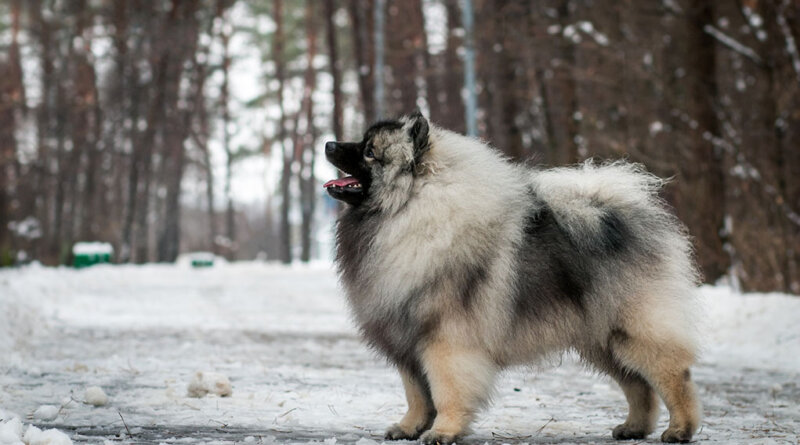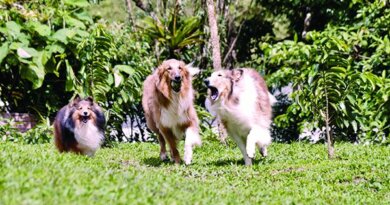Keeshond Dog Breed Profile – Top Dog Tips
The Keeshond dog breed is medium-sized dogs that are affectionate, playful, and intelligent, making them excellent pets.
Also known as the “Dutch Barge Dog,” the Keeshond dog is a breed that originated in the Netherlands. They are sweet-natured dogs that make loving and loyal companions.
Keeshonds are people lovers making them excellent family pets. These dogs like to be around their owner and participate in family activities.
They are part of the spitz family, with the Samoyed, Chow, and Pomeranian as their cousins. But the Keeshond is less independent than the others.
If you’re planning to adopt a Keeshond puppy, we’ll tackle everything you need about the Keeshond dog breed.
We’ve got you covered—from their history to their temperament and grooming needs!
Keeshond History
Some believe the Keeshond are descendants of the same arctic strains that made the Samoyed, Spitz, and Norwegian Elkhound.
Keeshonds are gentle and devoted to their people. That’s why some believed they were not bred to be hunting dogs. Rather, they were made to be companion dogs.
Long ago, in the 17th and 18th centuries, Keeshonds (pronounced KAYZ-hawnd) were bred to be companions and watchdogs on canal barges of his native land, Holland, and small boats called rijnaken on the Rhine River.
He was known as the Dutch Barge Dog for many years.
The Keeshond became the most loved dog in Holland as it became the symbol of the Patriot Party in the 18th Century.
Because at that time, Holland was divided into two sections: the prinsgezinden, also known as the followers of the Prince of Orange, and then we have the patriots or patriotten.
The Patriots’ leader Kees de Gyselaer, owned a dog named Kees. This led to their name, “Kees’ dog,” which is “Kees hund” in Dutch.
However, the followers of the Prince of Orange won against the patriots, and Keeshond’s popularity vanished.
And it became dangerous for people to own a Keeshond because of its political significance.
Centuries passed, and Keeshond came back with a vengeance. The breed started to gain its popularity back.
In 1920, Baroness van Hardenbroeak found Keeshond dogs from riverboat captains, farmers, and other working people.
She became interested in these dogs and started to breed them. In ten years, the Dutch Keeshond Club was formed.
Furthermore, in 1923, Carl Hinderer bred the first American Keeshonds litter. And the breed received recognition from the American Kennel Club in 1930.
Keeshond Physical Traits
Keeshonds are beautiful dogs and are known for their fluffy coats. They have a thick, double-top coat, a woolly undercoat, and longer guard hair.
The Keeshond dog breed is unsuitable for hot or humid climates because of its thick coats. It would be best to keep them in cold environments.
Their colors can be a combination of cream, grey, and black. These medium-sized dogs also have distinctive spectacle markings around their eyes.
Their eyes are also almond-shaped and are rimmed in black.
Their ears are set high on their heads and small, pointy, and erect. On the other hand, their nose is wedge-shaped and dark black.
Keeshond’s tail is furry, kept high, and bends over the back. A Keeshond varies in size and weight depending on gender.
Female Kees stands 17 inches tall, weighing at least 35 pounds. On the other hand, male Keeshonds are just a little bit taller, standing 18 inches tall and weighing 45 pounds.
Keeshond Temperament
As we’ve tackled above, Keeshonds were originally bred to be companion dogs.
They are also not hunters or other working dogs as they don’t have the desire for any specific job.
Nevertheless, these dogs are still highly intelligent and easy to train. They can learn canine manners where they can act politely on their own. Kees can also be good in obedience competitions.
However, they can get a little mischievous and stubborn, so you must be patient.
Keeshonds are active and affectionate dogs. Also known as the “Smiling Dutchman,” these dogs are delightful and playful, making them ideal family pets.
These dogs want to spread love and joy to all their family members.
Keeshonds are also alert dogs, making them excellent watchdogs. They are very sharp and will tell their owners if strangers are coming near their property.
Living with a Keeshond
Keeshonds are adaptable dogs. But it would be best to keep them in a cold climate.
Keeshonds can adjust to apartment living, but beware, as they are loud barkers which can be a nuisance for neighbors.
Also, it is not recommended for a Keeshond to be alone for long hours. These dogs are prone to separation anxiety.
Separation anxiety can lead to excessive vocalization, destructive behaviors, and house-soiling. So be sure not to let your Keeshond be left unattended.
Just like any other dog breed, Keeshonds will benefit from early socialization. Expose your Keeshond to different people, places, sounds, and adventures.
Socialization at a young age can help your pup be a well-rounded dog.
As pet parents, we must train children to properly approach, touch, or play with dogs. Supervise all of their interactions to help prevent unwanted biting and ear or tail pulling on both parties.
Training and Exercise
Since Keeshond dogs are very smart dogs, with their intelligence and curiosity, these dogs are easy to train. And just like socialization, training is best to start at a young age.
Keeshonds responds best to positive reinforcement training. These dogs can do well in obedience and agility.
But first, you’ll need to work on basic commands, such as sit and stay and proper leash walking manners.
You should also train their skills or commands to behave well with small children and other pets.
If you plan to adopt a Keeshond, remember that these dogs often struggle with separation anxiety. Helping them deal with this will be crucial in the future.
Slowly work on their alone time by leaving brief moments often and praising them when calm and well-behaved.
Keeshonds are medium-sized dogs that don’t need high exercise needs. They are not really for people who enjoy long runs.
Plan at least one vigorous walk daily, which can also be a way for you to exercise.
Health Care
The Keeshond is generally a healthy dog with a life expectancy of 13 to 15 years!
However, like other dog breeds, they are susceptible to certain health conditions you should look out for.
Finding a reputable breeder is best advised if you want to adopt a new pet. Trusted breeders can provide health clearances for the puppy and the puppy’s parents.
Below, we’ve gathered a few health problems that Keeshond dogs are prone to.
Hip Dysplasia
Hip Dysplasia is a hereditary condition wherein the socket of the joint and ball becomes distorted.
If your Kees gets diagnosed with hip dysplasia, it’s important to keep their weight within the standard range and have them exercise with activities that encourage joint therapy.
Your vet can prescribe medications for anti-inflammatory, pain relievers, and supplements for this illness.
If you want to prevent this condition, keep them active but not to the point that they might injure themselves.
Elbow Dysplasia
Like hip dysplasia, elbow dysplasia is a genetic condition. One possible cause of this condition is the different growth traits of the three bones that make up their elbow.
Dogs suffering from elbow dysplasia will suffer from painful lameness.
Your vet can recommend surgery to treat and correct the problem and will suggest your pup take medication to control the pain.
Patellar Luxation
Patellar Luxation occurs when the patella moves its alignment out of the femur. Similar to the conditions above. Like the ones above, patellar luxation is a hereditary disorder in dogs.
This can range from high to low levels of luxation, and each requires different treatments.
Symptoms may include skipping and kicking off the leg. It’s best to contact the vet for treatments, therapies, or procedures to help Keeshond with this condition.
If your Kees has been diagnosed with Patellar Luxation, it should never be bred anymore. It’s best not to bring these despairing conditions to their offspring.
Addison’s Disease
Addison’s Disease is a deficiency in the hormonal balance that causes the dog to have frequent gastrointestinal issues, unstable due to lack of an outlet for stress, and gradual loss of body state.
Even though it has no prevention, it is still best to have your dog checked up, and keeping their medications up to date may reduce painful effects.
Progressive Retinal Atrophy
Progressive Retinal Atrophy, or PRA, is another problem Keeshonds are prone to.
This degenerative condition affects the rod and cone cells in the eyes, leading to blindness.
It is also a hereditary disease known to have no treatment yet. Unfortunately, this disease can progress quickly from a year or two.
It is best advised to have your dog’s eyes frequently checked to reduce the risk of this condition.
Hypothyroidism
Hypothyroidism is the static function of the thyroid gland. In this condition, the dog’s metabolism is slowed down.
The immune system attacks the thyroid gland as it does not recognize it. It is also usually a genetic condition.
For Keeshonds experiencing lethargy, slow heart rate, weight gain, excessive shedding, and high cholesterol, it’s best to have them tested by a veterinarian.
The veterinarian may give maintenance and recommended diet. It’s best to have this condition checked and addressed immediately.
Cataracts
Cataracts are another eye problem Keeshonds are prone to. It is the gradual clouding of the lens in the eyes. It can impair their eyesight and even cause blindness in extreme cases.
Even though this is more common in elderly dogs, it can also be developed through genetics, traumatic eye injuries, nutritional deficiencies, or diabetes.
Have your pet undergo an ophthalmic examination to detect small cataracts as early as four to five years old.
To determine whether it is blinding, it is better to check with your veterinarian to be informed what procedure should be done.
Epilepsy
Epilepsy is a condition that causes mild or severe seizures in dogs.
It can be hereditary, caused by metabolic disorders, brain injuries, or tumors. Unfortunately, the cause of idiopathic epilepsy is still unknown.
Veterinarians may administer anti-seizure, but it can only reduce the severity of the seizure.
Ensure your Keeshond is checked immediately to provide the right medication for the disorder.
Diabetes Mellitus
Diabetes Mellitus is a chronic endocrine disease caused by insulin deficiency. This is often diagnosed in middle-aged or older felines and canines.
Treatment may depend on the case. Doctors may often recommend maintenance medication and diet restrictions to manage diabetes in dogs.
Grooming
Grooming is important not just for aesthetics but also to help prevent certain health issues.
As we’ve tackled above, Keeshonds have a dense and fluffy coat. However, that doesn’t mean that they’ll need extensive grooming requirements.
These dogs have fairly low-maintenance grooming needs. Brush them at least twice weekly to avoid matting and tangles, and you can bathe them as often as every three months.
You might think shaving their thick coats is best in the summer, but their coats are insulated. It keeps their body cool, and it protects them from sunburn.
Trim their nails regularly, at least once a month. When trimming their nails, a good rule is never to let them touch the ground.
Moreover, check his ears for dirt, redness, or bad odor since these can be symptoms of an infection. Wipe them carefully with a cotton ball dampened with ear cleaners.
Brush their teeth at least two to three times a week. Daily brushing is best recommended to avoid tartar buildup and remove bacteria lurking inside their mouths.
Frequently Asked Questions About Keeshonds
Is a Keeshond a good family dog?
Yes, Keeshonds are great family dogs. These dogs are smart, affectionate, and loyal dogs.
Their playful and loving nature makes them ideal family pets.
They are also suitable for first-time owners since they are highly intelligent and easy to train.
Are Keeshond dogs aggressive?
No, Keeshonds are rarely aggressive. These dogs are playful and lively. Keeshonds have a stable temperament that makes them great family companions.
Keeshonds also make excellent watchdogs because of their history.
Do Keeshonds make good guard dogs?
Keeshonds are much better as watchdogs than guard dogs since it is what they were made to do.
Keeshonds are too friendly and pleasant to be guard dogs. They get along with almost everybody.
However, they will still bark at strangers near your property, making them excellent watchdogs.
Keeshond Dog Breed Profile: Summary
If you plan to adopt a new pet, consider a Keeshond puppy. This Northern European dog breed is affectionate, friendly, and intelligent dogs.
Originally bred to be companions and watchdogs, these dogs have come a long way.
In this day and age, a Keeshond can be a great addition to the family. They can easily adapt to different kinds of lifestyles.
However, it is always recommended for them to live in cold climates.
These fluffy dogs are not just cute. Don’t let their looks fool you because they are also highly intelligent. And due to their brainpower, they are easy to train.
RELATED: GREAT PYRENEES DOG BREED PROFILE










